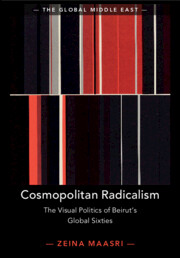Book contents
- Cosmopolitan Radicalism
- The Global Middle East
- Cosmopolitan Radicalism
- Copyright page
- Dedication
- Contents
- Plates
- Figures
- Preface and Acknowledgements
- Note on Transliteration and Translation
- Introduction
- 1 Dislocating the Nation
- 2 The Hot Third World in the Cultural Cold War
- 3 The Visual Economy of ‘Precious Books’
- 4 Ornament Is No Crime
- 5 Art Is in the ‘Arab Street’
- 6 Draw Me a Gun
- Conclusion
- Bibliography
- Index
- Plate Section
4 - Ornament Is No Crime
Decolonizing the Arabic Page from Cairo to Beirut
Published online by Cambridge University Press: 20 July 2020
- Cosmopolitan Radicalism
- The Global Middle East
- Cosmopolitan Radicalism
- Copyright page
- Dedication
- Contents
- Plates
- Figures
- Preface and Acknowledgements
- Note on Transliteration and Translation
- Introduction
- 1 Dislocating the Nation
- 2 The Hot Third World in the Cultural Cold War
- 3 The Visual Economy of ‘Precious Books’
- 4 Ornament Is No Crime
- 5 Art Is in the ‘Arab Street’
- 6 Draw Me a Gun
- Conclusion
- Bibliography
- Index
- Plate Section
Summary
In the late 1960s and 1970s a confluence of anticolonial politics and publishing revitalized the Cairo–Beirut link, itself emblematic of the turn of the century Arab nahda. This connection saw a reverse flow, which advantaged Beirut by way of Cairo’s amassed expertise in the publishing industry. Emerging Arab nationalist Beirut-based publishers relied on expertise in the production of illustrated books and periodicals developed in Cairo. Chapter 4 examines the subsequent Cairo–Beirut circuit of graphic design modernism, while probing the political relations and cultures of the visual carried through the influx of this expertise. The analysis brings to light a visual culture that embodies a modernist double claim of aesthetic authenticity, articulating Arab socialist politics with processes of artistic decolonization in and through printed mass media. The analysis is focused on Helmi el-Touni’s move from Cairo to Beirut in 1974 and his settling there for a decade, tracing the aesthetic and political relations articulated in his graphic design practice, while analysing in particular two sustained consultancies he undertook with Beirut-based Arab nationalist institutions: Beirut’s Arabic Book Fair and the Arab Institute for Research and Publishing.
Keywords
- Type
- Chapter
- Information
- Cosmopolitan RadicalismThe Visual Politics of Beirut's Global Sixties, pp. 132 - 162Publisher: Cambridge University PressPrint publication year: 2020

